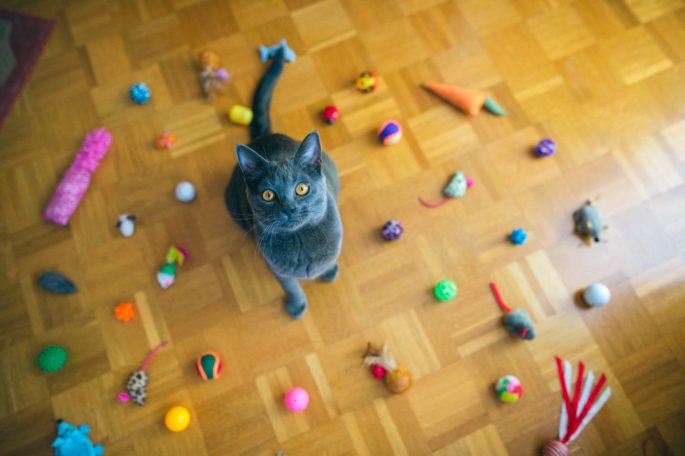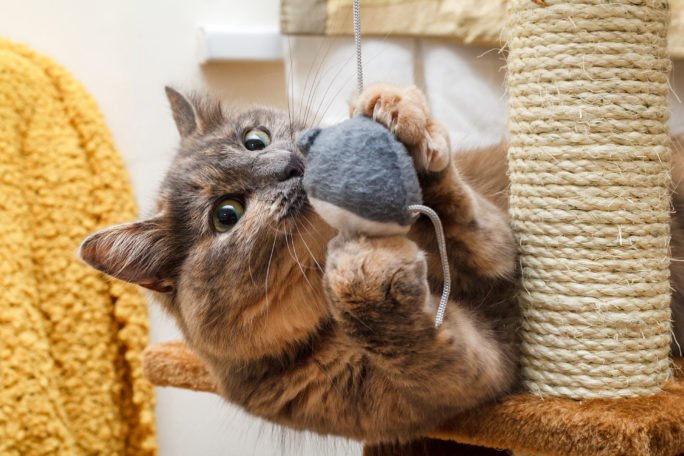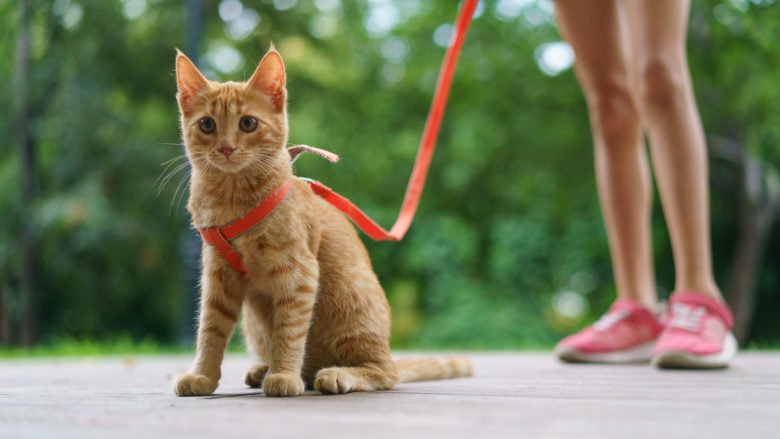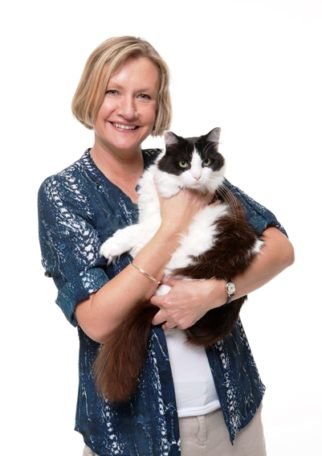Cats make an ideal family pet. In fact, a recent study by Purina Fancy Feast revealed that more than half (53 percent) of Australian cat owners admit their feline BF “completes them”. Which is completely understandable – they’re low maintenance pets, great company and good for a cuddle … most of the time.
Sometimes, cat behaviour can be aloof or anti-social. Their seemingly inexplicable quirks can often cause us to feel as though they completely dislike us. According to animal behaviouralist Dr. Jo Righetti, it’s actually quite the opposite and simply an inherently independent trait. Here, Dr. Jo chats to our pet columnist, Shonagh Walker, to unravel the mysteries behind some common cat quirks.
Cattitude
While some felines may enjoy our company all day long, others only appear to need us for essentials, such as food and water, or to let them in and out, and back in again, and back out again.
“Many people believe that cats are aloof or have ‘cattitude’, when in fact they can actually be quite social creatures,” explains Dr. Jo, adding, “it’s usually on their own terms.”
Solution?
“Try enticing them with things they love most. Do they love treats? Then call them over for one. If they love being fed, feed them smaller meals several times a day, which will provide more opportunity for interaction. Are they drawn to playing with toys? Engage them in a game of ‘cat and mouse’.”
Feeding Time
Most cats enjoy being fed smaller meals more frequently, with many enjoying a variety of flavours and textures, says Dr. Jo.
“Choose a variety of recipes and flavours. If they appear fussy with food it may help to serve their meal at room temperature, or to offer a different flavour. Cats are also very sensitive to bitter tastes and they can’t taste sweet flavours, so keep this in mind when selecting foods.”
More than one cat? Unlike dogs, they can typically be left to eat close to each other without a fight erupting. However, this isn’t always the case.
“Multi-feline households may benefit from more than one feeding area,” advises Dr. Jo.
It’s also important to have a designated area for meal times that is kept clean and tidy at all times.
“Ensure food is kept well away from litter trays,” stresses Dr. Jo. “Some cats even prefer their water to be separated from their food, while most fussy felines enjoy running or filtered water.”
You may wish to invest in a water fountain that filters water which filters out chemicals, keeps the water fresher for longer and is more enticing for your kitty to drink from.

Litter Box Conundrums
If you get your cat from a reputable breeder or rescue group, it’s likely they will have learnt the litter box ropes by the time they join your family. However, this is not always the case. Some kittens may never have used a litter tray before, which means the responsibility falls on you to house train them.
“Most quickly learn to use litter trays,” says Dr. Jo. “However, some may have only ever used soil. In this case, try adding soil to their litter tray, gradually replacing it with litter over time. This will make them more comfortable with the litter box and encourage them to use it more. “
“Also, always locate their litter box in private areas where they feels safe. Take them to their litter tray when they first wake up and again after every meal. Providing more than one litter tray can be useful, especially if you live with more than one cat. It’s important to always keep their litter box clean, too, otherwise they may refuse to use them.
“You can even have a litter tray build into household furniture these days which is great for small apartments. It is often best to go with what your cat is comfortable with, which will prevent little accidents around the house.”
Finally, try to keep a close eye on your cat’s toilet habits and the contents of the litter tray.
“Changes in toileting habits can indicate illness or stress,” warns Dr. Jo.

The Scratch
“Cats may use their claws as weapons, usually when they feel threatened or playful,” says Dr. Jo. “Ensuring they have a safe place to snuggle in and toys to play with can address any fears and anxieties as well as prove to be great boredom busters.”
Furniture scratching cats can be the bane of some feline parents’ lives. Dr. Jo advises investing in a scratching post or two. “Providing a variety of scratching posts in the locations that cats want to scratch usually helps solve this issue.”

The importance of sleep
“Cats often spending three-quarters of their day asleep,” says Dr. Jo. “They will often enjoy snoozing near you as you work, curling up on your lap, or even on your laptop.
Computer loving cats are attracted to the warmth it provides. If this provides a distraction to your tasks, try providing a nearby warm (not hot) water bottle or heat pack covered with their blanket or an item that has your scent on it,” advises Dr. Jo. “This will help settle your cat and prevent it disturbing your work.”

However, if your cat is clearly looking for attention, it may help to take a 10-minute break and engage your cat in play activities or snuggles. “Do this regularly and your cat will likely leave you to work in peace,” says Dr. Jo.
Cats are largely nocturnal beasts, too, which can be a source of sleeplessness for their humans.
Dr Jo advises to “tire out your cat with fun and games before bedtime.”

Feline Antics
Cats love games that involve hunting, so have a variety of toys on hand that allow them to chase and catch!
“Attach a toy on a string or ribbon to your waistband and walk around your home and let your cat pounce on the toy,” advises Dr. Jo. “Boxes or tunnels to hide in to will also keep your cat amused and entertained.”
You can also buy cat toys that are battery operated or motorised that provide a great chase game for hours.

Cats And Dogs
Depending on the breed of dog, cats and canines can get along well and become great “siblings”. Before bringing a cat and dog into your family, first check that your chosen breed of dog doesn’t have an instinctive prey drive, which is genetically evident in breeds like Siberian Huskies, Alaskan Malamutes, Jack Russel Terriers and many more.
When you are introducing a dog to a cat, or vice versa, it’s important to do it slowly and set up their initial encounters in a positive environment, advises Dr. Jo. “Give your cat space to move away and position itself up high, so it can feel comfortable, whilst keeping the dog on a lead. During their encounter, offer both animals a treat for remaining calm in the presence of the other.”

Indoor safety
Cats are happiest when at home, and also, where they are safest. Cats left to wander are not only at risk of being hit by a car, or being harmed by stray dogs, they may harm or kill our native species, being natural predators themselves.
Keeping your cat secure at home, with an outdoor secured area, is best at all times. If you want to give them space to explore, Dr. Jo reminds us that “cats can be trained to walk on a harness.”

Body language And Behaviour
Cats communicate with us constantly, through a variety of body language postures and gestures. When they rub against us, they are transferring their scent to us, which is a way of marking ‘ownership’ of us, making us one of their belongings. Slow blinks and winks communicate that they are comfortable with us, while rolling over in front of us is their way of getting our attention.
“Enjoy their special way of communicating with you, as this shows how much they love your company and you,” says Dr. Jo.
Cat chat
Cats communicate with us by meowing and purring.
“Every cat’s purr is unique,” comments Dr. Jo. “Purring appears to have evolved as a soothing behaviour, calming the cat but often calming us too. Meowing has evolved to get human attention. Their little feline chirrupy meow/purr, known as a solicitation meow or purr, ensures that we give them the attention or food they desire.
“Cats also have a special little quivery sound and mouth action that they make when watching birds out of the window. This is an act of excitement. It may also be linked to another feline behaviour called the flehmen response, a lip-curling movement that is a half sniff, half taste reaction where the lips are pulled back and the nostrils inhale the air to obtain information.
“Another feline interaction that we may see, but not hear, is the silent meow. Not all cats do this but if yours does, this is just an ultra-quiet meow they make at their disposal when your cat is ready to tell you exactly what they want, when they want it and how much they love you.”
About Dr. Jo Righetti
Dr Jo Righetti is an animal behaviourist dedicated to helping people understand their pets. She has three cats at home, all with ‘cattitude’ and work with a variety of organisations and companies to help enhance the purrfect pussycat life.








